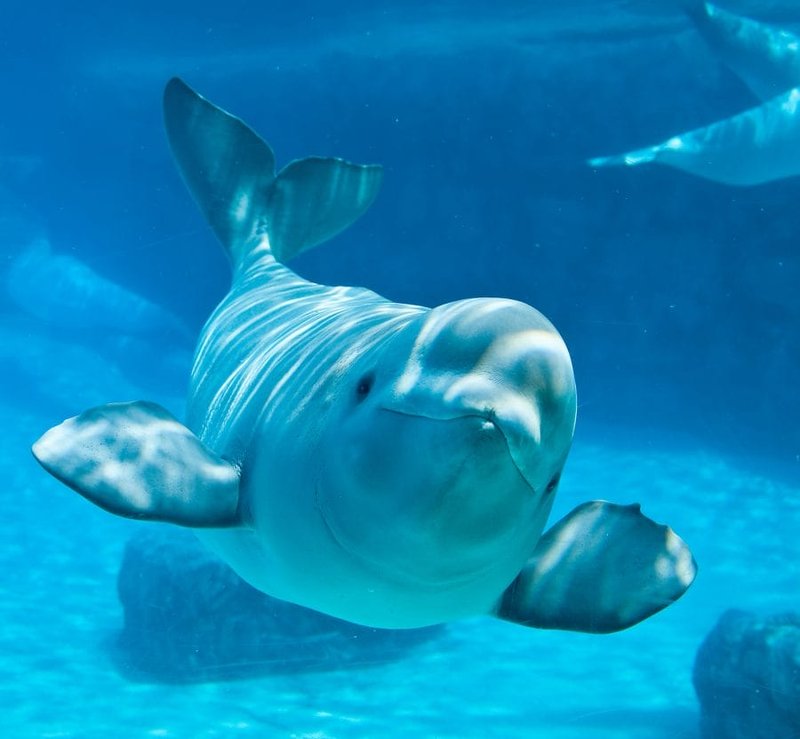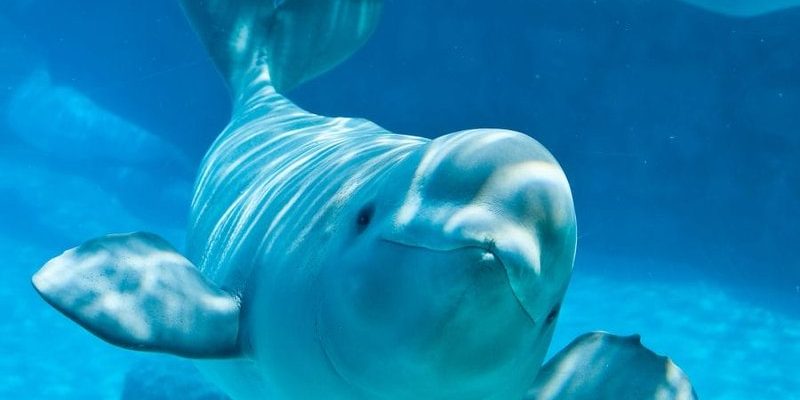
Beluga whales are small, sociable, and incredibly expressive, making them easy to love. They inhabit the cold Arctic and sub-Arctic waters, which makes them a bit of a mystery to many. So, grab your favorite cup of coffee, and let’s dive into ten intriguing facts about these charming white whales that might surprise you!
1. Unique Coloration
One of the most striking features of the beluga whale is its color. Unlike many other whales, belugas are known for their white skin, which can make them look almost ghostly in the water. This is especially noticeable when you see them swimming beneath floating ice.
Juvenile belugas, on the other hand, start off a bluish-gray color. They gradually lighten as they mature, turning a full white by the time they reach adulthood, usually around 5 to 10 years old. This change in color helps them blend into their icy surroundings, providing natural camouflage from predators.
You might wonder why they need this adaptation. In the Arctic waters where they live, icebergs and snowy landscapes are common, and being white helps them avoid detection, not just from prey but also from potential threats like orcas.
2. Social Creatures
Belugas are incredibly social animals, often found in groups called pods. These pods can range from a few individuals to hundreds! Imagine a large family reunion, where everyone is sharing stories and catching up. That’s what beluga pods are like, although their communication sounds a bit different.
They are known for their vocalizations, which include clicks, whistles, and even some sounds that resemble a squeaky toy. These sounds aren’t just for show; belugas use them to communicate with each other, navigate their icy environment, and even hunt. When you hear a group of belugas ‘talking’ to one another, it’s like tuning into a lively conversation among friends.
But why are they so social? These interactions help strengthen bonds within the pod, making hunting, playing, and even parenting duties more efficient and enjoyable.
3. Incredible Adaptability
You might be surprised to learn that belugas are one of the few whale species that can swim in shallow waters. They are incredibly adaptable, capable of navigating through tight spaces in ice-covered areas. This adaptability extends to their diet as well.
Belugas are opportunistic feeders. They consume a variety of food, including fish, crustaceans, and even some forms of invertebrates. Think of them as the omnivores of the sea! This flexibility means they can thrive in a range of environments and food shortages don’t hit them as hard as some other species.
Their ability to adjust to different habitats is also crucial as climate change impacts their icy homes. Belugas are facing shifting food sources and changing habitats, so this adaptability will be key to their survival.
4. Unique Vocalizations
Have you ever heard of a whale that sounds like a bird? That’s exactly what belugas do! They’re known as the “canaries of the sea” because of their wide range of vocal sounds. From squeaks and whistles to chirps, these vocalizations can be used for communication and navigation.
Their vocal cords are very flexible, allowing them to produce sounds at different frequencies. This versatility is vital for locating each other in the murky, ice-laden waters where visibility can be low.
Additionally, researchers believe that these sounds play a significant role in their social interactions. They can express emotions or social states, much like how we use different tones in our voices. Imagine a cluster of belugas sharing stories and experiences through their beautiful array of sounds!
5. Echolocation Abilities
Believe it or not, belugas have an impressive echolocation system. This means they can “see” their environment using sound. By emitting clicks and listening to the echoes that bounce back, they can determine the size, shape, and distance of objects around them.
This skill is especially helpful in the dark waters of the Arctic, where light is scarce. The ability to navigate using sound allows them to hunt more effectively and avoid obstacles. Think of it like a sonar system—much like how bats navigate in the night sky.
This echolocation also helps them locate prey and communicate within their pods. Without this amazing ability, life in the icy waters could be much more challenging for them!
6. Complex Migrations
Belugas are known for their migratory habits, often covering long distances in search of food and optimal living conditions. They typically migrate in the spring and fall, moving from colder waters to more temperate regions.
These migrations are not just a leisurely swim; they follow a specific pattern based on environmental factors and food availability. During summer, they prefer shallower, warmer waters, which are rich in fish.
Interestingly, they often return to the same areas year after year, much like how some birds return to the same nesting sites. This behavior shows their strong connection to their environment and their understanding of where to find the best resources.
7. Conservation Status
Despite their fascinating adaptations, belugas face several threats, making conservation efforts crucial. Their habitats are shrinking due to climate change and the melting of Arctic ice, which impacts their food sources and breeding grounds.
Additionally, pollution, ship traffic, and industrial activity in their environments pose serious risks. This means that belugas are not just cute and fascinating creatures; they’re also indicators of the health of the Arctic ecosystem.
Organizations around the world are working to protect their habitats and mitigate threats. Supporting these efforts is essential for ensuring that future generations can enjoy the beauty and wonder of beluga whales.
8. Long Lifespan
Belugas can live quite long compared to many marine mammals. On average, they live between 30 to 50 years, but some have been known to live even longer. This longevity means they can form deep social bonds and even have relationships across generations.
Interestingly, female belugas often live longer than males. As they age, older belugas play a vital role in teaching younger members of their pods, passing down knowledge and social behaviors that ensure the survival of their community.
It’s quite touching to think about the family dynamics that exist in a beluga pod, where generations of whales learn from and support one another.
9. Unique Teeth Structure
Unlike many other whales, belugas only have around 32 teeth, and these teeth are not used for chewing. Instead, they help the beluga grip its slippery prey. Think of them as more of a tool than a necessary feature for eating.
Belugas are known to swallow prey whole, making their tooth structure quite specialized for their unique feeding habits. They often hunt fish and squid, so their teeth allow them to catch and hold onto these fast-moving meals effectively.
This adaptation is just another example of how well-beluga whales have evolved to survive in their challenging environments.
10. Playful Nature
If you’ve ever watched belugas swim, you might have noticed how playful they can be. They often engage in activities like rubbing against ice, playing with seaweed, and even swimming alongside boats. Their playful behavior is not just for fun; it helps them socialize and strengthen bonds within their pods.
Researchers have observed that play can also help young belugas develop their skills for hunting and navigating. So, every time you see a beluga leaping out of the water or spinning in circles, remember, they’re not just having a good time—they’re also practicing important life skills!
In conclusion, beluga whales are much more than just charming marine mammals. Their unique adaptations, social structures, and playful nature make them a fascinating subject of study and admiration. As we learn more about these creatures, we can better protect them and their habitats, ensuring that belugas continue to thrive in our oceans for generations to come. So next time you think of the sea, don’t just picture the large whale or playful dolphin—remember the captivating beluga and all the wonders it holds!

